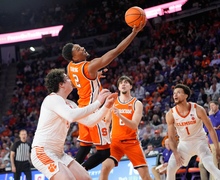In a flash: students bring flash mobs to campus in a variety of ways
Students bombarded Schine Student Center and boogied down, others sunbathed on the Quad in 50-degree weather and during finals week more than 1,600 students are expected to participate in Syracuse University’s next flash mob.
One minute these mobbers are average passersby, and, literally in a flash, they might be frozen in place or sparking what first appears to be a spontaneous ‘Thriller’ dance for anyone nearby to witness. Fueled by text messages and other social media connections, flash mobs have appeared across the world since their start in 2003.
Despite there being such a wide variety of flash mobs, there are several aspects that define each one, said Dr. Judith A. Nicholson, an assistant professor at Wilfrid Laurier University in Ontario, Canada, who studies flash mobbing. Like the flash mob planned for finals week and organized over Facebook, they’re widely publicized, primarily with new and mobile technology. Each mob is scheduled for a specific time, and is well documented to be later posted on the Web.
‘Through that documentation they live on,’ Nicholson said. ‘I think through that living on, it creates inspiration for someone to do something different.’
Though the first flash mobs occurred in heavily populated department stores and train stations, the trend is beginning to make appearances at college campuses, including SU.
At the start of this semester, members of First Year Players appeared to be taking ‘everyday walks through Schine,’ – some talking with friends near the Box Office, some near the dining center – then migrated toward the building’s atrium. Two people began dancing, then four, six, and eventually all 15 dancers.
Ray Lapena, a senior public relations major and the public relations director of First Year Players, was inspired to start a flash mob at SU after watching a YouTube video of flash mobbers assembling to dance to ‘Do-Re-Mi’ in a Belgium train station. Planning for the mob began in June.
‘It seemed like a great way to grab attention while reflecting exactly what we do as a musical theatre organization,’ Lapena said.
The group used a Twitter account and began following people, then tweeting vague clues leading up to the planned date every week or so. The day before the mob, the time and place were released via Twitter, and the group also handed out slips of paper that read, ‘Flash mob at SU?’ with the time and place the morning of. The atrium was filled with spectators by 12:20 p.m., the time publicized by the group.
‘It was obviously to promote (First Year Players), but people really just wanted to do it for fun,’ Lapena said.
The following month, about 20 students from The NewHouse, an student-run advertising agency, assembled on the Quad to sunbathe and promote awareness of global warming in support of Hopenhagen, a group in Denmark. This flash mob publicly spread through word of mouth and Facebook.
‘They got to the middle (of the Quad), took out their beach towels and broke out the suntan lotion. They had Frisbees and sunglasses, some people were wearing bikinis, swim trunks,’ said Joseph Misiewicz, a senior advertising and psychology major who helped organize it.
The temperature, he remembers, was 48 degrees.
A video posted on YouTube shows that these flash mobs were preceded by another that took place on the Quad. In February 2008, students flocked to the epicenter of campus for the sole purpose of making snow angels.
‘It’s so interesting how different each flash mob can be,’ Lapena said. ‘At least for me, when I hear ‘flash mob,’ the first thing that comes to mind are the impromptu dancers that are on YouTube, but the Hopenhagen one was just as absurd and grabbed just as much attention.’
Mary O’Brien, a reference archivist for SU Archives, compared the trend to the popularity of streaking during the ’70s at SU.
‘There are lots of ’70s Onondagans (yearbooks) with pictures of people running around naked through campus,’ she said.
Nicholson predicts flash mobbing is more than a temporary trend since its roots go back to movements like the French Revolution.
‘The moment people realized they could use their bodies as a technology, to sort of shift space and bend space, I think that because that has existed for so many centuries, flash mobs will continue,’ she said.
Some say flash mobs shortly went out of style after their start in 2003, when corporations began using them for advertising purposes. Others consider the trend to be alive and well, fueled by social media and used in the form of political protests, Nicholson said.
Modeled after flash mobs that have taken place at other universities, the flash mob planned for finals week has confirmed almost 1,700 participants on Facebook. Organizing began in September, a DJ is planned and Red Bull contacted the mob’s planners for a sponsorship deal, said Alex Kapnek, a sophomore chemistry major.
‘There might be something about college and university campuses that are causing people now to say we need to stop and pause and look at what’s happening here,’ Nicholson said.
Published on December 7, 2009 at 12:00 pm





